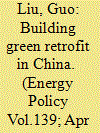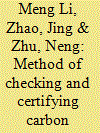| Srl | Item |
| 1 |
ID:
176702


|
|
|
|
|
| Summary/Abstract |
Green retrofit is an effective way of improving the performance of existing buildings to achieve low energy consumption and low carbon emission. To realize a successful building green retrofit, it is important to understand the barriers and to develop relevant policies for retrofitting existing buildings, especially in developing countries. As a typical developing country, China has a large number of aged buildings with high green retrofit potential. In terms of its government structure, economic development, and building stocks, China is unique in that it poses a unique set of barriers and policy strategies on the promotion of building green retrofit. Based on a critical review, existing retrofit policies in China were reviewed. Then, the barriers to building green retrofit within the context of China were identified. Based on the study of existing policies and barriers, relevant policies for addressing these barriers are recommended. The findings provide a valuable reference for policy makers in China to review current building green retrofit policies or to develop new policies that address the barriers. This study also provides a useful reference for other countries aiming to review their building green retrofit policies.
|
|
|
|
|
|
|
|
|
|
|
|
|
|
|
|
| 2 |
ID:
125631


|
|
|
|
|
| Publication |
2013.
|
| Summary/Abstract |
In China, the area of existing buildings in urban and rural has exceeded 43 billion m2 at present and more than 90% of them are high energy consumption buildings, which have poor thermal insulation performance, low energy efficiency technologies and equipments, and severe energy waste in HVAC system. Carbon trading in construction field not only promotes energy efficiency retrofit of existing buildings and energy-saving technologies, but also reduces the financial pressure of government. The most important technical issue is how to estimate the carbon trading volume reasonably. Based on the requirements of energy efficiency retrofit of existing buildings, relevant national or professional standard standards and CDM small scale project methodologies, this paper puts forward a simplified and practical method of checking and certifying the carbon trading volume of existing buildings retrofits in China and calculates four typical cases for trail. Moreover, a comprehensive methodological framework is presented to make the method guide actual cases more directly and apparently. The framework comprises project analysis, scenario determination, data collection and envelope calculation.
|
|
|
|
|
|
|
|
|
|
|
|
|
|
|
|